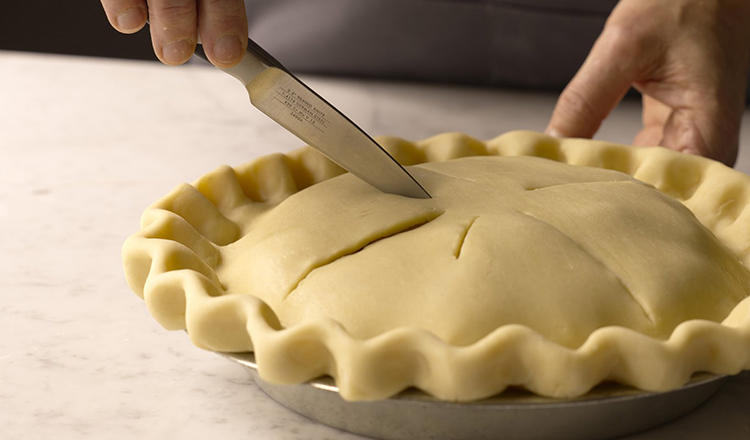Makes two discs (enough for two, single-crust pies or one, double-crust pie)
Ingredients
- 3 cups all-purpose flour
- 1 teaspoon kosher salt
- 1 teaspoon sugar
- 1 cup (2 sticks) unsalted butter, cold, cut into ¾-inch cubes
- 1/3 cup water, ice cold, plus more as needed
Directions
- In the bowl of a stand mixer, combine the flour, salt, and sugar.
- Place the bowl in the freezer for 30 minutes, or until the bowl and ingredients are well chilled.
- Remove the bowl from the freezer and place it on the mixer. Using the paddle attachment, blend the dry ingredients on low speed for 15 seconds, or until combined. With the mixer off, add the butter pieces to the mixing bowl. Mix on medium speed for 1 to 2 minutes, or until the butter is in pieces no larger than small walnuts, but no smaller than peas.
- With the mixer off, sprinkle approximately half of the ice-cold water over the mixture. Mix on low speed for 30 to 60 seconds, or until just combined. Continue to add water in small amounts until the dough transitions from a slightly powdery appearance with chunks of butter to that of a rough and pliable dough. The dough should just hold together when pressed to the side of the bowl. It should not form a ball or mass of dough in the bowl.
- Turn the dough out onto a lightly floured work surface. Shape the dough into one or two 5- to 6- inch discs, depending on whether you are following the single- or double-crust recipe. Wrap discs tightly in plastic wrap. Chill the dough in the refrigerator for at least 1 hour, or preferably overnight.
Rolling the Dough for Single- or Double-Crust Pies:
Directions
- Place the rolling pin in the center of the dough, with one end of the pin at 9 o’clock and the other at 3 o’clock. Applying firm, even pressure with the rolling pin, roll outward from the center. Never roll over one section in the same direction repeatedly, as this can toughen the dough.
- Rotate the dough 90 degrees to the right when rolling. This allows you to evenly roll the dough in all directions, creating a consistent thickness and preventing the dough from sticking.
- As you rotate the dough, frequently check the uniformity of the thickness by running your forefinger and thumb together with the dough in between. Adjust the rolling pin pressure as needed. If the dough is rolled too thick, it may not bake properly. If rolled too thin, it may rip or tear. In order to avoid an irregular shape, press the dough inward and together to maintain a circular shape while rolling.
- Gently lift the dough and set it into the pan, pressing it into the edges of the pan. Do not force or stretch the dough or it may shrink during baking.
- Trim the dough using a pair of scissors, leaving 1 to 2 inches overhanging, depending on the type of decorative border around the edge of the pan.
- Gently fold and press the extra dough under the inside of the pan edge to form a thick border. (If using a top crust, leave the edge unfolded.) Refrigerate the formed shell for 1 hour and then place it in the freezer 30 minutes before blind baking, or before filling and baking.
- For a double crust pie: Transfer the top crust to the filled pie, carefully settling the crust over the filling and being careful not to stretch or thin the crust. Trim both edges to approximately 1/2-inch and press the edges of both the top and bottom crusts together to seal them. Fold the dough under to make it flush with the edge of the pan, press the edge flat, and form a decorative edge as desired.
- Using a sharp knife, cut four to eight slashes running from the center to the edge, into the top crust.
- For an appealing finish, use a pastry brush to apply an egg wash to the top crust, then sprinkle with decorative sugar, such as sanding sugar, pearl sugar, or turbinado sugar.


